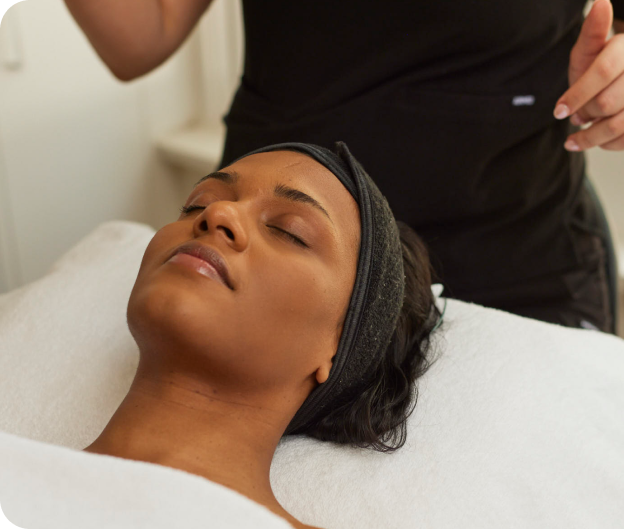
Hyperpigmentation can be caused by inflammatory conditions such as acne vulgaris, dermatitis & impetigo. Let's discuss how to treat skin discolouration.
Inflammatory Pigment Changes in BIPOC
The incidence of inflammatory based pigment changes in black, indigenous, and other people of colour (BIPOC) are greater than those seen in Caucasian communities.
Particularly, BIPOC suffering from inflammatory conditions like acne vulgaris, dermatitis and impetigo are at higher risk of developing post inflammatory hyperpigmentation (PIH).
How long does it take to resolve hyperpigmentation?
Some forms of hyperpigmentation can take years to resolve without treatment, which in turn can have a lasting impact on mental wellbeing and self confidence.
Reasons for Melanin Colour Changes
Melanocytes are a type of cell that produces melanin, the substance in the skin that gives it its colour. These specialised cells sit at the basal layer of the epidermis, where the two main layers of the skin meet.
When exposed to certain external or intrinsic factors such as;
- UV radiation
- Biochemical triggers
- Medications
These factors can stimulate cells to produce more melanin, leading to visible pigmentary changes.
Reasons for Higher Pigment Colour Changes in BIPOC

The exact reasons why pigment changes, or dyschromia, appear to affect BIPOC at higher rates are not clearly understood.
The mechanisms/pathogenesis of hyperpigmentation are also ambiguous but there is evidence that certain chemical factors, such as interleukins and oxidative stress associated with inflammation, can contribute to increased melanocytic activity.
How Topical Treatments Work
Supress Distribution: Topical treatments to resolve PIH often revolve around inhibiting the biological processes that form the melanin granules and suppress its distribution into the visible skin.
Suppress activity: The gold standard ingredient that addresses PIH and other pigmentary disorders is hydroquinone (HQ), a prescription only medication that is able to interfere with the biological pathways that produce melanin.
Improve appearance: Specifically, HQ and other ingredients like azaelic acid, kojic acid, alpha-arbutin, some licorice extracts and tranexamic acid suppress the activity of tyrosinase, an enzyme required for the conversion of melanin from its precursors, and consequently improves the appearance of hyperpigmentation.
Promote clearance: Incorporating these ingredients into a regime can help suppress the formation of new hyperpigmentation and promote clearance of existing macules.
Dr Pigment Plus for BIPOC Individuals
The aspect dr pigment plus is a product that is formulated with many of those above ingredients, apart from HQ, and is generally well tolerated. For BIPOC individuals with sensitive acne-prone skin, azelaic acid based formulations could be more useful given its comparatively low irritancy profile, anti-inflammatory and anti-microbial properties.
The Dual + by Dermaceutic combines azeliac acid and a derivative with other potent pigment inhibitors to reduce melanogenesis and increased activity in keratinocytes (skin cells that produce protein) to ultimately also help control acne.
Other options for Post Inflammatory Pigment Changes
In addition to pigment inhibitors, other treatments include;
- Exfoliants
- Antioxidants such as vitamin A
Exfoliants and antioxidants can also help in improving the clarity of the skin as it promotes skin cell turnover.
Products like Mela Cream by Dermaceutic have combined pigment inhibitors with vitamin A for a more streamlined approach to addressing PIH, melasma and ageing concerns. This product is ideal for a candidate well acclimated to chemical exfoliants, who does not have any sensitivities, and who is not currently battling acne.
What are some inflammatory conditions that can cause post inflammatory hyperpigmentation (PIH)?
Conditions such as;
- acne vulgaris
- dermatitis
- impetigo
Reducing and Maintaining Dyschromia with Sun Care
Dyschromia is a patchy or irregular skin discoloration. As always, photoprotection is another important component in reducing and maintaining dyschromia both in BIPOC and other ethnic communities.
A broad-spectrum sunscreen with a SPF 50+ should be used daily and be the last step in the morning skincare routine.
*************
Written by Susan Anthony, BBioMed, Dermal Therapist. Ms Anthony is highly passionate about beauty, technology & medical aesthetics. Ms Anthony has a Bachelor of Biomedical Science and a Bachelor of Applied Health Science.
